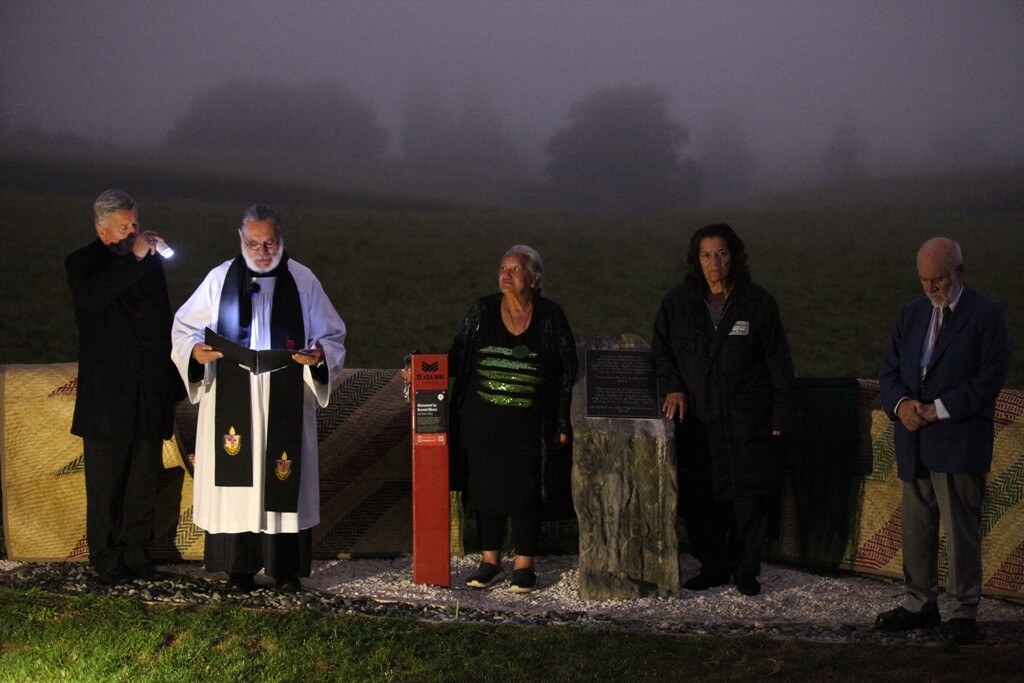
Archdeacon Turi Hollis speaks at the dawn service at Rangiaowhia – with the help of torch bearer archbishop David Moxon. Also pictured were Hazel Wanda, Moepatu Borell and Tom Roa. Photo: Steph Bell Jenkins
The value of Aotearoa’s new history curriculum was made clear to Waipā students this week.
After about 50 people gathered in the mist on Tuesday for an annual commemoration of one of the country’s most controversial incidents, students from one Waipā school told how it had all been news to them.
Pupils from St Peter’s Catholic School in Cambridge expressed astonishment at the fact they had known nothing of history in their own district at Rangiaowhia – where a confrontation between Māori and pakeha took place more than 150 years ago.
“We were amazed as we delved deeper into the history of Rangiaowhia and learnt about its people, culture and their lifestyle,” said Valentina Di Maio, a student at St Peter’s Catholic School in Cambridge, speaking to a gathering at the Holy Angels Catholic mission site and urupa on Tuesday.
“My parents didn’t even know what it was, and when I told them of the incredibly well-run community that was known as the ‘food bowl of Auckland’ they agreed with me that this is something important that should be shared and remembered within New Zealand.”
Lying between Cambridge and Te Awamutu, Rangiaowhia was a thriving village where Māori and pakeha lived together harmoniously for more than two decades.
However, on February 21, 1864, British forces attacked it. A thatched building caught fire and an elderly man who ran out raising a white blanket above his head was shot, as were two others who tried to escape. There are conflicting views on how many died inside the burning building.
The students’ comments came in the week new Prime Minister Chris Hipkins acknowledged he left school with more knowledge of Tudor England than his own country.
The new history curriculum being rolled out in schools and focusing on New Zealand this year has roots in Rangiaowhia. In 2015, students from Ōtorohanga College, aware of the Rangiaowhia story, presented a petition to parliament supporting a more New Zealand based history curriculum.
There were about 400 school students at this week’s commemoration and among the more than 100 adults was a strong representation from the Catholic and Anglican churches which have enjoyed a close relationship with the community.
The chair of the Ngati Apakura Runanga Trust, Bill Harris, said the commemorations were an opportunity for Ngati Apakura and Ngati Hinetu to recognise the losses they had suffered.
“It hurts us when Jacinda… and this shouldn’t be a race or a competition, but when Jacinda says the first terrorist attack in New Zealand was in Christchurch, that’s just not true. And for somebody that comes from this area to make a statement of that nature really hurts as well.”
Roto-o-Rangi Rd resident Harland Sinclair, who attended Tuesday’s 6am service at 61 Rangiaowhia Rd with his seven-year-old daughter Kenzie, said he felt it was disgusting he hadn’t learnt about Rangiaowhia until he was 40.
“I think this particularly tragic event should be better known and better commemorated,” he said.
“It would never on the scale of Anzac Day or anything like that, but similar, where work starts a little bit later or something like that and enables people to come and commemorate properly and learn the history of it.”








